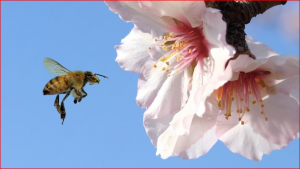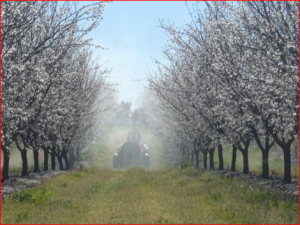 Almond pollination in California requires the use many colonies or hives of bees. This year, more than 1.6 million bee colonies were used to pollinate the California Almond crop. Nearly all of these colonies were brought in from other states by an army of 1,300 commercial beekeepers.
Almond pollination in California requires the use many colonies or hives of bees. This year, more than 1.6 million bee colonies were used to pollinate the California Almond crop. Nearly all of these colonies were brought in from other states by an army of 1,300 commercial beekeepers.
This staggering number of honeybee colonies accounts for approximately ninety percent of all of the honeybees in the United States. After pollinating almonds, these bees are often used to pollinate other crops, such as apples, cranberries, cherries and watermelons. Any losses seen during or right after almond pollinating season cascades into the pollination of other crops and into the packaged bee industry, which is what allows new beekeepers to start colonies and existing beekeepers to replace winter losses.
At an impromptu meeting on March 24 in Los Banos, California between beekeepers and the U.S. Environmental Protection Agency, 75 beekeepers stated that three-quarters of their hives showed very significant damage. More beekeepers weighed in later. It was found that after waiting a few more weeks approximately 60% of all colonies that pollinated almonds showed damage. That is nearly a million honeybee colonies.
The reason why the pesticide losses do not happen right away is because of bee biology and the way bees work to produce their young in the hive. Bees gather pollen an nectar and store it for later use. This includes the raising on new bees. Since bees only live about 28 days, new bees are being raised all the time in a healthy colony. When nectar and pollen is contaminated it will continue to kill bees even after the bee that brought it to the hive is long gone. This is why such a high percentage of colonies say dying brood, or young bees still in the cells, on such a large scale. Many of the pesticides in use are labeled as “safe for use on adult bees.” This means that these pesticides were only tested on bees that were flying around but the testing never included any investigation into brood rearing or other long term exposure issues.
Beekeepers in California are blaming their losses on pesticides used on the Almond trees. Almond growers have no restrictions on when and how they can apply pesticides to their trees and that is a large part of the problem, but an even bigger part are that the residue from these pesticides kill bees and kill bee brood, no matter when it is applied.
The EPA and the USDA have claimed for years that pesticides are not hurting honeybees and other pollinators. This event shows absolute proof on a large scale that pesticides used on Almond trees are dangerous to honeybees. These are the same chemicals that are used on the vast majority of food crops in the United States. Almond growers typically apply one or a mix of pesticides – which can include clothianidin, dinotefuran, imidacloprid and thiamethoxam. This year tank mixing from two new products, tolfenpyrad and cyantraniliprole were used.
The EPA and t he USDA has failed to keep pesticides from killing pollinators. Instead pesticide related bee deaths have increased exponentially. Because of this and the fact that the beekeeping industry is deemed as insignificant, beekeepers are not protected by any laws or given payment for damages caused by pesticide exposure. This is despite the fact that pollination services provided by honeybees are responsible for 30 billion dollars worth of food annually.
he USDA has failed to keep pesticides from killing pollinators. Instead pesticide related bee deaths have increased exponentially. Because of this and the fact that the beekeeping industry is deemed as insignificant, beekeepers are not protected by any laws or given payment for damages caused by pesticide exposure. This is despite the fact that pollination services provided by honeybees are responsible for 30 billion dollars worth of food annually.
Not only has the EPA and USDA done nothing to protect pollinators, but they have done nothing to assure consumers that any of the above mentioned pesticides are truly safe to be used on food crops. All beef and dairy cows are exposed to them on a daily basis through the corn silage they eat. Nearly all commercially raised vegetables are sprayed with them. Even the plants you purchase at home and garden centers in the spring have been treated with them. After the sprayers have left the fields and treated seeds have sprouted and been harvested as a food, everybody forgets about the pesticides that may be present. Nobody knows exactly how much of these systemic pesticides make it into the food chain as corn products, soybeans products, dairy products, beef, and fruits and vegetables. To date, no official testing has been done on this yet.
If the losses in the beekeeping industry do not stop, the beekeeping industry cannot continue to survive. New regulations, stiff penalties and fines for those responsible for colony death, and the banning of insecticides, fungicides and insect growth inhibitors are the only way to save the industry before it dies with the bees.
To read more about this issue, please read the press release from the Pollinator Stewardship Council or visit this topics thread on their website.